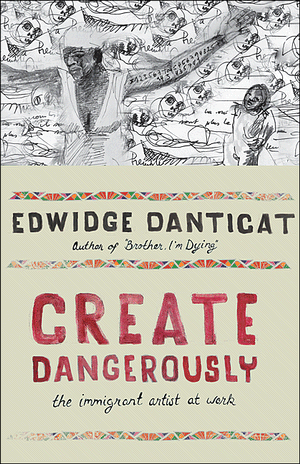Writers Read: Create Dangerously by Edwidge Danticat
 Create Dangerously begins with an essay about the public executions of Louis Drouin and Marcel Numa in Port-au-Prince. Drouin and Numa were Haitians who had met while living in New York City and had returned to Haiti as part of a guerrilla army that intended to take down the Duvalier dictatorship. François Duvalier—Papa Doc—made sure that thousands of Haitians were there to witness the executions. Danticat’s essays pay homage to the myriad ways the event impacted her life as a writer, as well as the lives of many other Haitian artists and activists. The immigrant artist at work educates and moves the reader to enter the experiences of artists who do not belong anywhere and hence endure the suffering of their homeland, their new home, and the liminal space in between in which their identities are concocted.
Create Dangerously begins with an essay about the public executions of Louis Drouin and Marcel Numa in Port-au-Prince. Drouin and Numa were Haitians who had met while living in New York City and had returned to Haiti as part of a guerrilla army that intended to take down the Duvalier dictatorship. François Duvalier—Papa Doc—made sure that thousands of Haitians were there to witness the executions. Danticat’s essays pay homage to the myriad ways the event impacted her life as a writer, as well as the lives of many other Haitian artists and activists. The immigrant artist at work educates and moves the reader to enter the experiences of artists who do not belong anywhere and hence endure the suffering of their homeland, their new home, and the liminal space in between in which their identities are concocted.
Create Dangerously shows us how art grows like wild weeds from the cracks in a dictatorship. Danticat tells of a time during Pap Doc’s regime when writers could not write, and if they did so, risked their lives and the lives of their families. Instead they put on Greek tragedies inside homes. If they wrote and shared, it was in secret. For many American artists, we cannot imagine living like this, but it is crucial that we recognize the possibility that this could happen here. And we must understand that this is the reality of so many artists all over the world. In the book’s title essay, the act of creating dangerously is described as “creating when both the creation and the reception, the writing and the reading, are dangerous undertakings, disobedience to a directive” (11).
As I write this, ICE is detaining immigrants and literally tearing families apart. Create Dangerously challenges how we view the immigrant experience and invites us to see Haiti, a country that has been so overlooked by our citizens and so slighted by our government.
In “Acheiropoietos,” Danticat profiles photographer Daniel Morel, who as a child, was present for the assassinations of Drouin and Numa. He describes the feeling that as an artist, he is viewed negatively inside Haiti and has “little value” (142) in the US. Again, she defines creating dangerously, this time as creating “fearlessly, boldly embracing the public and private terrors that would silence us, then bravely moving forward even when it feels as though we are being chased by ghosts” (148). How can folks who feel they have “little value” be moved to create? How heartbreaking that anyone should feel they have little value, and how true of so many people in this country.
In “Another Country,” which deals with how we talked about suffering and poverty after Hurricane Katrina, Danticat writes, “I don’t know why it seems always to surprise some Americans that many of their fellow citizens are vulnerable to horrors that routinely plague much of the world’s population” (111). She cites newscasters comparing the view of New Orleans to Africa or saying that it was like “another country.” Danticat’s nod to Baldwin with her title is important. Baldwin’s work addresses American denial and shortsightedness. Katrina proved this. The mainstream media kept pointing out how the events occurring in New Orleans were like another country, in total denial that this was OUR country, America.

Edwidge Danticat
Danticat honors many immigrant artists in her work, like Michael Richards, a Jamaican-American sculptor, known for a piece called Tar Bay vs. St. Sebastian that depicts an airman pierced all around by several small planes. Richards died in his studio in the Twin Towers on September 11th. In “Welcoming Ghosts,” Danticat draws parallels between Basquiat and an untrained Haitian artist and Vodou priest named Hector Hyppolite, who was “discovered” in a small town in Haiti and held in high regard by artists like Andre Breton. Danticat honors these artists by drawing political and spiritual through lines between their works and showing the reader how they were often misunderstood.
In “Bicentennial,” Danticat cites Alejo Carpentier’s description of encountering the “real marvelous” in Haiti, something like magic realism. She writes:
The real marvelous is the extraordinary and the mundane, the beautiful and the repulsive, the spoken and the unspoken. It is the enslaved African princes who believed they could fly and knew the paths of the clouds and the language of the forests but could no longer recognize themselves in the so-called New World. It is the elaborate vèvès, or cornmeal drawings, sketched in the soil at Vodou ceremonies to draw attention from the gods. It is in the thunderous response from gods such as Ogoun, the god of war, who speak in the hearts of men and women who, in spite of their slim odds, accept nothing less then total freedom. (103)
Lately, my words do not seem like enough. My donations do not seem like enough. This brief moment of attention I have paid to Haiti is certainly not enough. Danticat’s work forces the reader to see more than we are accustomed to seeing. More art, more suffering. And more examples of how we can write from a place that is real for each of us. For me that means I cannot forget the privilege, with which I walk through this “New World.” Maybe I can walk through it comfortably, but many cannot recognize themselves here.
Danticat, Edwidge. Create Dangerously: The Immigrant Artist at Work. Random House, 2010.
 Meredith Arena is from New York City and resides in Seattle where she works as a teaching artist in the public schools and facilitates meditation for adults. She is a student in the MFA program at Antioch University Los Angeles. She is the Blog Editor and the Diana Woods Memorial Award Editor on Lunch Ticket. Her work has appeared in Entropy, Lunch Ticket and SHIFT Queer Literary Arts Journal.
Meredith Arena is from New York City and resides in Seattle where she works as a teaching artist in the public schools and facilitates meditation for adults. She is a student in the MFA program at Antioch University Los Angeles. She is the Blog Editor and the Diana Woods Memorial Award Editor on Lunch Ticket. Her work has appeared in Entropy, Lunch Ticket and SHIFT Queer Literary Arts Journal.




